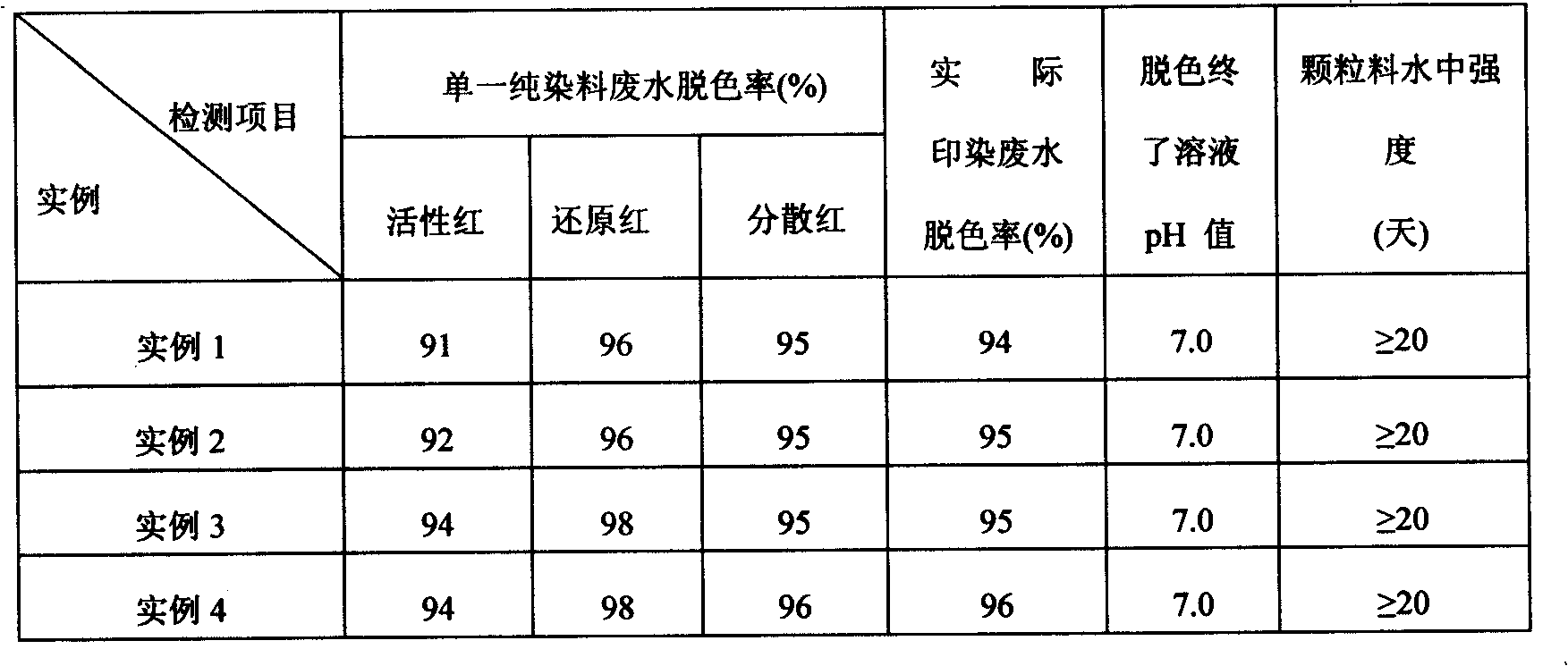Method for producing decoloring material of printing and dyeing waste water
A manufacturing method, printing and dyeing wastewater technology, applied in the direction of adsorption water/sewage treatment, ion exchange water/sewage treatment, flocculation/sedimentation water/sewage treatment, etc., to achieve excellent chemical comprehensive decolorization ability, avoid complexity, and reduce production volume Effect
- Summary
- Abstract
- Description
- Claims
- Application Information
AI Technical Summary
Problems solved by technology
Method used
Image
Examples
example 1
[0018] Hangjin 2# clay 100kg, coarsely crushed to more than 80 mesh, mixed with H at a concentration of 1.0mol / L 2 SO 4 Use a solid-liquid ratio of 1:3, activate at 95°C for 2 hours, then neutralize with 5mol / L NaOH to a pH value of about 7.5, separate the solid and liquid once, granulate into 3-5mm pellets, dry at 90°C, and then After calcining at 750°C for 3 hours, 85kg of printing and dyeing wastewater decolorization materials can be obtained. The produced filtrate is evaporated and concentrated, crystallized and separated to obtain Na 2 SO 4 10H 2 The O by-product is about 70kg, and the mother liquor is recycled. The particle strength of the decolorizing material and its decolorizing effect on a single pure dye with different properties and actual printing and dyeing wastewater are shown in Table 1.
example 2
[0020] Hangjin 2# clay 100kg, coarsely crushed to more than 80 mesh, mixed with H at a concentration of 1.5mol / L 2 SO 4 Use a solid-liquid ratio of 1:2.5, activate at 95°C for 2 hours, then neutralize with 5mol / L NaOH to a pH value of about 7.5, separate solid-liquid once, granulate into 3-5mm pellets, dry at 90°C, and then After calcining at 750°C for 3 hours, 90kg of printing and dyeing wastewater decolorization materials can be obtained. The produced filtrate is evaporated and concentrated, crystallized and separated to obtain Na 2 SO 4 10H 2 O by-product about 80kg, mother liquor recycling. The particle strength of the decolorizing material and its decolorizing effect on a single pure dye with different properties and actual printing and dyeing wastewater are shown in Table 1.
example 3
[0022] 100kg of Hangjin 2# clay, coarsely crushed to above 40 mesh, mixed with H at a concentration of 2.0mol / L 2 SO 4 Mix with a solid-liquid ratio of 1:2.0, activate at 90°C for 1.5h, then neutralize with 5mol / L NaOH to a pH value of about 7.5, separate solid-liquid once, granulate into 3-5mm pellets, and dry at 90°C. After calcining at 750°C for 3 hours, 90kg of printing and dyeing wastewater decolorization materials can be obtained. The produced filtrate is evaporated and concentrated, crystallized and separated to obtain Na 2 SO 4 10H 2 O by-product about 80kg, mother liquor recycling. The particle strength of the decolorizing material and its decolorizing effect on a single pure dye with different properties and actual printing and dyeing wastewater are shown in Table 1.
PUM
| Property | Measurement | Unit |
|---|---|---|
| particle size (mesh) | aaaaa | aaaaa |
Abstract
Description
Claims
Application Information
 Login to View More
Login to View More - R&D
- Intellectual Property
- Life Sciences
- Materials
- Tech Scout
- Unparalleled Data Quality
- Higher Quality Content
- 60% Fewer Hallucinations
Browse by: Latest US Patents, China's latest patents, Technical Efficacy Thesaurus, Application Domain, Technology Topic, Popular Technical Reports.
© 2025 PatSnap. All rights reserved.Legal|Privacy policy|Modern Slavery Act Transparency Statement|Sitemap|About US| Contact US: help@patsnap.com

